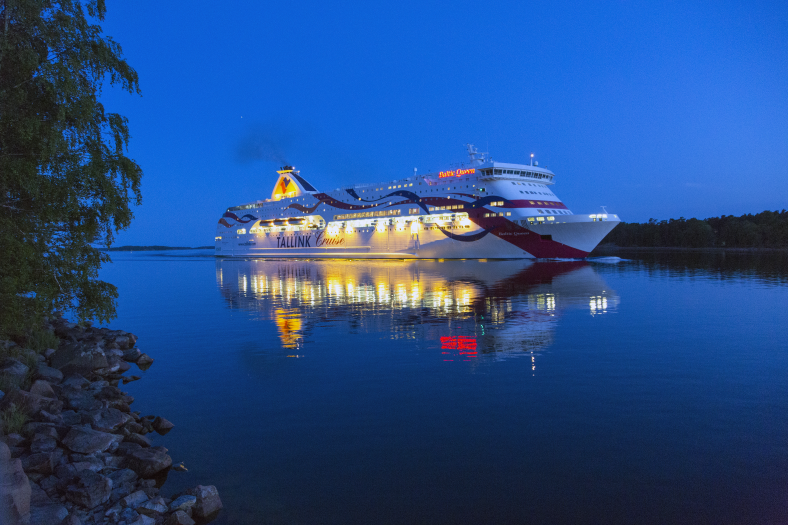Tallink Grupp’s passenger ferry Baltic Queen, operating on the company’s Tallinn-Stockholm route, underwent recently, in early September this year, a planned technical maintenance in Naantali, Finland, where, in addition to various works on the vessel’s hull and interior, various technological and environmentally friendly renewals and upgrades were also carried out.
As one of the major technological upgrades carried out, the vessel’s propeller blades were replaced with new and more innovatively shaped blades which enable to increase the efficiency of the ship’s propulsion device in accordance with the ship’s operational needs. This enables to reduce the vessel’s fuel consumption and also cut emissions at the same time. In addition, today’s testing results demonstrate that it has been possible to reduce also the underwater noise generated by the ship.
Whereas the ship’s decreased fuel consumption already shows positive initial results, but still requires a more detailed additional analysis, the company already has the results which show the reduction in underwater noise.
To measure possible underwater noise reduction as a result of changing the vessel’s propeller blades, the shipping company partnered with Tallinn University of Technology (TalTech), who measured the initial underwater noise level produced by the former propeller blades prior to the vessel’s planned docking from 30 August to 4 September 2023, and again, after the planned docking and installation of the innovative new propeller blades, from 15 to 25 September 2023.
The measuring results showed that 40Hz decidecade source level with the new propeller blades, moving at the speed of 17,6 knots, is by 16 ± 5 dB lower and that broadband source level in decidecades from 20 Hz to 20,000 Hz with the new propeller blades, moving at the speed of 17,6 knots, is lower by 8± 5 dB.
This means that the acoustic pressure radiated into the water at low frequencies is now at least three times, and at all frequencies combined, at least twice as low as with the old propeller blades.
According to Tallink Grupp’s Head of Ship Management and Chief Captain Tarvi-Carlos Tuulik, such results are most gratifying indeed and encourage the company to continue to look for and pilot environmentally friendly solutions.
”Every new solution, which helps us as a company to reduce the negative impact on the natural environment around us is most positive indeed and achieving good results inspire us to find more and more such solutions. Solutions that have a positive effect in multiple ways, such as Baltic Queen’s new propeller blades, are particularly pleasing as they reduce fuel consumption, emissions and underwater noise at the same time.”
Commenting on the cooperation on measuring the underwater noise, Aleksander Klauson, Professor of Structural and Fluid Mechanics at the Institute of Civil Engineering and Architecture, Tallinn University of Technology (TalTech), said:
– “Ships are a major source of continuous underwater noise at sea. Reducing ship noise is an important environmental issue, as underwater noise disturbs marine mammals and fish and can lead to habitat degradation and declines in marine species populations.
– “The European Union deals with the issue of human-induced marine underwater noise through The Marine Strategy Framework Directive where one of the characteristics of good environmental status of the sea is that the continuous underwater noise is at a level that does not harm the marine environment. Several international organizations, such as the International Maritime Organization (IMO), are also working hard to make shipping as environmentally friendly as possible”.
According to Klauson, the measurement results once again prove that ship propellers are the main source of underwater noise, due to the fact that when the blades rotate, a phenomenon such as cavitation occurs, i.e., the formation of steam bubbles in the water near the rotating propeller blade.
“The measurements demonstrated that by optimizing the ship’s propeller, it is possible to mitigate cavitation and significantly reduce the underwater noise caused by the passenger ship,” added Klauson.
The innovatively shaped new propeller blades of Tallink’s passenger ship Baltic Queen have been designed and manufactured by Kongsberg Maritime Sweden AB especially for this type of ship, considering the speed ranges required for the ship’s operation. Fuel and emissions savings from the new blades are expected to be at least 14%. If the collected measuring results confirm the aforementioned savings and the pilot project of the new blades on the Baltic Queen is considered successful, Tallink Grupp will also extend the use of the innovative propeller blades to other ships across the company’s fleet.
Source: tallink.com


















